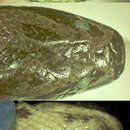en
names in breadcrumbs


Masked water snakes of the genus Homalopsis are abundant in the low elevation wetlands of Southeast Asia. They are the largest members of the family Homalopsidae, exceeding 1.3 m in total length, with robust bodies, wide heads, usually a distinctive pattern of alternating brown and cream bands outlined in black, and usually a pale colored venter with paired dark spots on the lateral edge of the ventrals and first dorsal rows of scales. Masked water snakes are nocturnal ambush predators preying on small fish, and their large size and interesting dorsal pattern makes them a target for the novelty leather industry.
Currently, five species are recognized, H. buccata Linnaeus inhabits the Indonseian Archipelago and the adjacent mainald. Stuart et al. (2006) resurrected H. nigroventralis Deuve, aMekong drainage endemic with disjunct populations scattered in Loas, Thailand, Vietnam, and Cambodia. Murphy et al. (2012) revalidated H. hardwickii Gray a species known only from the type specimen and it lacks a type locality. The species is supected of inhabiting northeast India and possibly Nepal. They also revalidatedHomalopsis semizonataBlyth a species known from Kawkareik, Twante near Rangoon, and Mottama, Myanmar. This species may be more widespread than known specimens suggest. Its known distribution is centered on the Gulf of Martaban, but it may extend to the north following the Ayeyarwady River and to the south following the Andaman Sea’s coastal plain in southern Myanmar and along the Andaman coast of peninsular Thailand.The recently describe Homalopsis mereljcoxi is an Indochinese species and is exploited in the snake harvest at Tonle Sap, in Cambodia (Brooks et al. 2007).
Like all homalopsid snakes Homalopsis is viviaporus and females give birth to relatively large young.